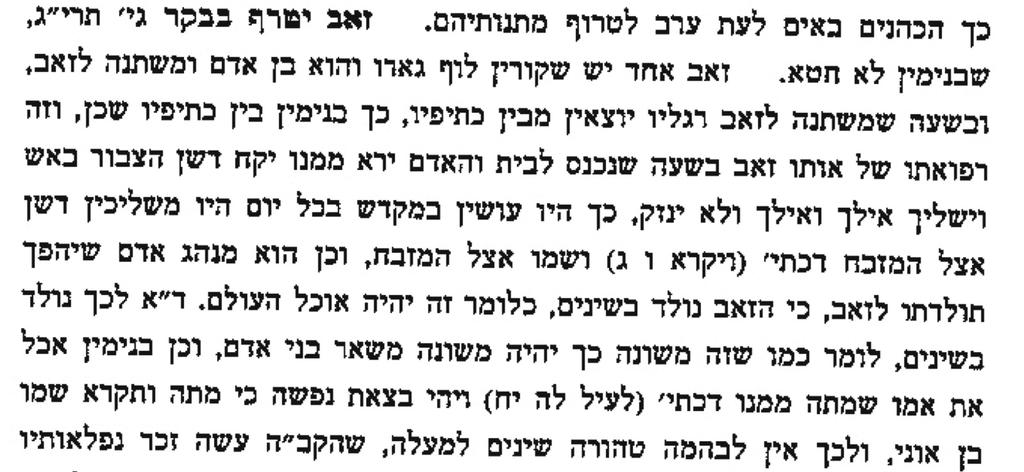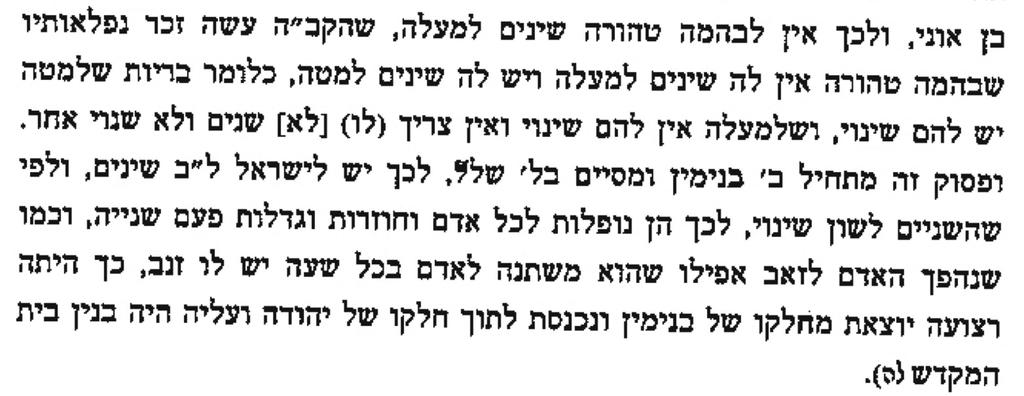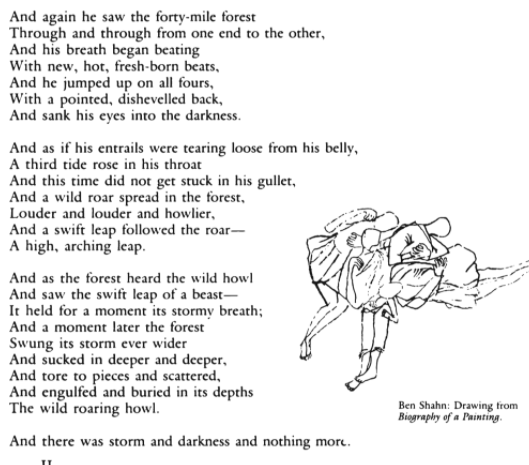In the morning he consumes the foe,
And in the evening he divides the spoil.”
פירוש רבינו אפרים, פרשת ויגש
כי בנימין היה זאב יטרוף בני אדם לעתים, וכשבא לו העת שנהפך לזאב שנאמר בנימין זאב יטרף, ובעוד שהיה אצכ אבין נשען על הרופא ובאותו זכות לא היה נהפך לזאב, שכך אמר ועזב את אביו ומת, כלומר כשיפרד מעביו יהפך לזאב לעוברי דרכים והיה כל מוצאו יהרגו.
Rabbenu Ephraim's Commentary from R. Natan Slifkin
Benjamin was a ravenous wolf, who would occasionally maul people -- and when the time came for him to turn into a wolf, as it says, "Benjamin is a ravenous wolf" (Gen. 49:27), if he was with his father he could rely on a physician, and in that merit would not turn into a wolf. Thus it says, "and if he leaves his father he will die" (Gen. 44:22) -- that is to say, if he separates from his father he will turn into a wolf [and attack] people on the way, and anyone who encounters him will kill him.

There is a type of wolf that is called loup-garou (werewolf), which is a person that changes into a wolf. When it changes into a wolf, his feet emerge from between his shoulders. So too with Benjamin—“he dwells between the shoulders” (Deuteronomy 33:12). The solution for [dealing with] this wolf is that when it enters a house, and a person is frightened by it, he should take a firebrand and thrust it around, and he will not be harmed. So they would do in the Temple; each day, they would throw the ashes by the altar, as it is written, “and you shall place it by the altar” (Leviticus 6:3); and so is the norm with this person whose offspring turn into wolves, for a werewolf is born with teeth, which indicates that it is out to consume the world. Another explanation: a werewolf is born with teeth, to show that just as this is unusual, so too he will be different from other people. And likewise, Benjamin ate his mother, who died on his accord, as it is written, “And it was as her soul left her, for she was dying, and she called his name ‘the son of my affliction’ ” (Genesis 35:18). (Commentary to Genesis 35:27)

As a result, ritually pure animals do not have upper teeth, for the Holy Blessed One ‘‘created a remembrance of His wonders’’ (Ps. 111:4): that pure animals do not have upper teeth, but do have lower teeth, to indicate that lower creatures are sub- ject to change [shinui], while [the creatures] above are not subject to change. . . .
This verse (i.e. Gen. 49:27) begins with [the letter] bet, Binyamin [‘‘Benjamin’’], and ends with lamed, shalal [‘‘spoils’’]. Therefore Jews have 32 teeth [the alphanumerical equivalent of lamed-bet]. Since teeth [shinayim] recall change [shinui], they fall out of every person and grow in a second time. And just as a person who turns into a wolf has a tail at all times, even when he is in human form, so too a strip [of land] linked the allotment of Benjamin with the allotment of Judah, upon which the Temple was built.
-Translation by Shyovitz
Christians and Jews in the Twelfth-Century Werewolf Renaissance by David I. Shyovitz
This reading links werewolves to an arcane element of the Temple service, the terumat ha-deshen, or ‘‘offering of ashes.’’ Just as, according to Leviticus 6, the priests would ceremonially collect and dispose of the ashes of the altar (itself located in the territory of Benjamin!), one who is confronted by a werewolf should utilize ashes as a means of defending himself. The Pietistic commentary reinforces this linkage between werewolves and the tribe of Benjamin by immediately pointing out that ‘‘Benjamin ate his mother, who died. As it says, ‘As she breathed her last—for she was dying— she called his name Son of My Trouble (Ben Oni)’ (Gen. 35:18).’’32 Like the ‘‘ravenous’’ wolf of Gen. 49:27, and like contemporary werewolves, Benjamin metaphorically ‘‘devoured’’ his mother, who died while giving birth to him. That Benjamin’s mother’s name was Rachel—Hebrew for sheep, the prey of wolves—no doubt lent credence to this reading of the verse.
Eleazar of Worms (1176 - 1238), Sodei Razyya vol. 2

Tzelem is ze’ev in the albam system; therefore, those people who change into wolves were created as such from the Six Days of Creation, and do not return to their earlier state until they have eaten the blood of a man or woman. (Commentary to Genesis 2:28)
Christians and Jews in the Twelfth-Century Werewolf Renaissance by David I. Shyovitz
Now, it seems unlikely that Eleazar is claiming that both humans and wolves were created in God’s image, much less that God is Himself a werewolf. Given the meaning of lycanthropic transformation charted above, however, it seems that in exegetically linking tselem with ze’ev, Eleazar is suggesting that werewolves in wolf form remain indelibly linked to their humanity—to the extent that the werewolf in both states retains its tselem elohim, or divine form. A man who apparently transformed completely into a beast is still considered a reflection of the Divine, precisely because such a man does not completely transform. Werewolves transform outwardly but maintain their essential humanity; the cryptographic link between tselem and ze’ev implies that a werewolf is still a person. This passage confirms yet again that werewolves were not merely a popular superstition credulously incorporated into Pietistic writings. Werewolves were invested with deep theological meaning, and allowed the Pietists to chart out a unique approach to human embodiment, in which bodies can retain stabil- ity even as they utterly transform.
(א) יש נשים שקורין להן סטרייאס מרש ורוולש אותן נבראו בין השמשות שיעשו דבר וישתנו מברייתן. אשה אחת היתה סטריאה והיתה חולה ביותר והיו שתי נשים בלילה עמה אחת היתה ישנה ואחת היתה ערה ואותה החולה עמדה לפניה והיתה מנפצת שערה ורצתה לפרוח ורצתה למוץ דמה של ישנה והעירה הקיצה הישנה ותפסו את החולה השטריא ואחר כן ישנה עוד והערה לא היתה ישנה עמדה השטריא והיתה מנפצת שער ראשה ורצתה לפרוח והעירה הקיצה הישנה ותפשו את החולה השטריא אם היתה מזקת להמית את אשה אחרת היתה השטריאה חיה וכיון שלא יכלה להזיק מתה השטריא כי צריכה את אשר בא מן האדם לבלוע הדם והבשר. וכן מרולף ולפי שהמראו השטריאה צריכין לנפץ שערם קודם שיברחו לכך משביעין אותן שתבאי בנפוץ שער ולא תהא רשאה לצאת אלא ברשותי ומי שמכה למזקת אז כשרואה אותה אינה יכולה לחיות אלא אם כן תאכל מלחם ומלח של מכה אותה. וכן אם הזיקה הניזק צריך לאכול מלחם ומלח שלה וחוזרת הנפש כבתחילה:
"1465 There are women that are called estrie... They were created at sunset [before the first Sabbath before creation]. As a result of this, they are able to change form. There was one woman who was a estrie and she was very sick and there were two women with her at night; one was sleeping and one was awake. And the sick woman stood up and loosened her hair and she was about to fly and suck the blood of the sleeping woman. And the woman who was awake screamed and woke her friend and they grabbed the sick estrie, and after this she slept. And moreover, if she had been able to grab the other woman, then she, the estrie, would have lived. Since she was not able to hurt the other woman, the estrie died, because she needs to drink the blood of living flesh. The same is true of the werewolf. And since....the estrie need to loosen their hair before they fly, one must adjure her to come with her hair bound so that she cannot go anywhere without permission. And if a estrie is injured or seen by someone, she cannot live unless she eats of the bread and salt of the one who struck her. Then her soul will return to the way it was before.
The Serpent was walking on two and he had semblance slightly similar to that of a man. You should know that those who are able to turn a man into a wolf, a cat or a donkey - his eyeball does not change and so the serpent who underwent a change - his eyes did not change. Therefore one who miscarried and the fetus had a form of a snake - the mother is ritually impure as one who gave birth because his eyeballs are similar to those of a man.
A man was once born with teeth and a tail. People said, ‘‘He will eventually eat people—better to kill him [now].’’ A certain sage said to them, ‘‘Remove his front teeth, and cut off his tail, so that his body will be equal to that of any other man, and he will be unable to harm anyone.’
Eventually with much pushing, nagging, and cajoling, her husband told her the secret of the magic ring. But as soon as she knew the real source of their wealth, the rabbi’s wife began to plot…
She asked to see the ring, and when the rabbi refused, she cried out that he did not love her anymore. When he still did not relent, so she put a flea in his ear till he gave her the ring to look at.
As soon as the ring was in her hand the rabbi’s wife made a wish: “I wish that God would turn my husband into a werewolf and let him run around in the forest with the wild beasts.”
That is how the rabbi became a werewolf running around deep in the woods.
He began to eat people in the forest. He attacked intruders. Everybody throughout the land was terrified to go there.
The townsfolk wondered where there rabbi had gone but thought as before, that perhaps he had gone traveling to study and teach insome far off Yeshiva. The town became miserable once more in the rabbi’s absence. The poor became poorer, and there was no-one to feed and house the students of Torah. But the rabbi’s wife, she seemed to get richer and richer, as she got herself everything she wanted.
The rabbi in the shape of a werewolf continued to invoke terror in everyone’s hearts, for there is no animal stronger than a werewolf. No one was willing to kill the werewolf who was stronger than iron and as smart as a human being.
The Wolf by H. Leyvik (Yiddish, 1920)


Message From a Yiddish Werewolf by Dara Horn, Tablet Magazine 2019
When I first encountered this poem years ago, I was riveted by the Rov, whom I understood as a person disfigured by trauma. The poem, I thought, was a call for empathy for survivors, and a warning about how “hurt people hurt people”—though the latter idea in this context felt false to me even then, a cheap After School Special idea about “prejudice” that was untrue to the survivors I knew, and also untrue to the poem itself (where only the Rov winds up dead).
But after the Pittsburgh massacre, I read this poem differently—and, I suspect, in a way much closer to how American readers in 1920 may have read it. Insert here all the insultingly obvious caveats about how a lone gunman murdering 11 people in no way resembles 50,000 dead. Those caveats don’t matter for this poem, because this poem isn’t about history. It is about fear.
The poem, as I now understand it, isn’t really about the Rov, whose point of view hardly figures in the work. It’s about the other Jews, whose shared emotions are intimately described—and all too familiar. These Jews rejoice in their survival, but they are also haunted by the horrific fact that other Jews have been murdered while they have randomly been spared—the defining fact of post-Holocaust American Jewish identity. The wolf’s presence in their midst is an embodiment of that haunting, the deep awareness of total vulnerability that lurks just beneath the surface of their daily lives.
Leyvik tells us as much. As the poem’s Jews listen to the wolf’s midnight howling, “they could not hear a thing anymore / Except the beating of their own hearts.” Later, as the howling grows louder and closer, “in each turn of the voice was heard / A hidden challenge, an appeal, and above all, a pleading; / Which chilled their hearts more than anything, / For it reminded them of the cry of a human being.” This disfigured beast crying for mercy is inseparable from who they are. It is part of them, one of them, the buried part of thousands of years of pain. They want that wolf to go away, but they cannot kill it without killing themselves.
Wolf Man’ writer reflected wartime Jewish experience, by Susan King LA Times, 2010
Screenwriter Curt Siodmak was a German Jew of Polish descent who fled Europe for Hollywood in the 1930s to escape persecution from the Nazis. So there’s little wonder that his 1941 Universal horror classic “The Wolf Man” parallels the experiences of Jews in Europe before and during World War II.
“The Wolf Man” revolves around an everyman, Lawrence Talbot (Lon Chaney Jr.), who arrives at his father’s mansion in England after years of living in America. One evening, he’s bitten by a werewolf in the forest and finds himself turning into a vicious beast whenever the moon is full.
Filled with self-loathing for what happened to him, Talbot fears not only what he might do to his friends and family but also being hunted down and killed...
Even the pentagram in Talbot’s hand signifying a werewolf is a “very obvious substitute for the Star of David, and if you had that symbol you were going to be cursed,” Nasr says.
“That is not how Siodmak felt as a Jew but how he felt others perceived him. Larry Talbot was an interesting substitute for what was going on with the Jewish people in the early 1940s.”
What’s So Jewish About Werewolves? By Esther Saks, Jewcy 2017
One of the biggest sources of unease in a werewolf story is the inability to pick one out of a crowd. They look like you, they sound like you, they could be any of you. Josh and George are nice Jewish boys growing up to be nice Jewish doctors and upstanding members of society before they are cursed, cast out of society and forced to live mouth-to-mouth, way station to way station, unable to settle down or find peace. Though they look just as normal as the next person, the vampires are able to sniff them out. An existence that had seemed integrated is once more Othered, and these characters are forced to wrestle with their identity as wolf or human.
Werewolf Bar Mitzvah, from 30 Rock
It's a full moon on the Sabbath
I was working late on my Haftorah
When I heard a knock on my bedroom-doorah
I opened it up and to my surprise
There was a werewolf standing there with glowing gold eyes
He says tomorrow my son, you will be a man
But tonight's the time to join the wolfen clan
Tomorrow you will stand at the bimah and pray
But tonight let's gaze at the moon and bay
Werewolf Bar Mitzvah
Spooky scary
Boys becoming men
Men becoming wolves x2
The next day what happened
The Talmud didn't teach,
I got up in front of everyone
To give my little speech
Then my teeth turned into fangs
And my nails into claws
And I nearly dropped the Torah
When my hands turned into paws
I growled and I roared
And my rabbi did as well
It was a rocking werewolf zoo
At Temple Beth-Emmanuel.
Werewolf Bar Mitzvah
Spooky scary
Boys becoming men
Men becoming wolves
We had a reception at the Larchmont Country Club
They served a real nice brisket and an eight foot party sub
I danced with my cousins, I got money from my folks
We had a lot of fun making circumcision jokes
Then I remembered the premise of my song
I was at a nice reception but the werewolf part was gone
So we pulled ourselves together and we're wolf men again
Just in time for monster fight to begin,
All the country club employees were brain sucking pack
Who had all turned into zombies and were on the attack,
So we fought them and some Dracula's and Frankensteins too
'Cause you gotta love Bar Mitzvah, even if you're not a, aroo!
Werewolf Bar Mitzvahs
Spooky scary
Boys becoming men
Men becoming wolves
Werewolf Bar Mitzvah
Kooky hairy
Boys becoming men
Men becoming wolves



